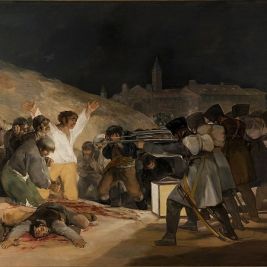
Abstractionism: an inverted painting as a precursor to a new style
Abstractionism - a style of painting and art in general that rejects the realistic reproduction of the surrounding world. Its followers depict simple and complex forms, play with color, use lines, planes, and other elements, combining them in such a way as to evoke specific emotions in the viewer. This approach sets them apart from masters who adhere to classicism and many other styles. At first glance, a painting by an abstractionist may appear to be a chaotic jumble of lines, shapes, and spots. Upon closer examination, it becomes clear that the artist has created a cohesive composition designed to evoke certain thoughts or moods in the viewer.
 Abstractionism. Wassily Kandinsky. First Abstract Watercolor, 1910-1913
Abstractionism. Wassily Kandinsky. First Abstract Watercolor, 1910-1913
Abstractionism as a painting movement emerged in 1910 when the Russian artist and theorist of visual art, Wassily Kandinsky (Russian: Василий Кандинский), painted his first abstract watercolor. The painter himself later recounted that he simply turned one of Claude Monet's paintings upside down. He felt that it looked much better in that orientation than in the usual one, and that inspired him to use abstractions in his own work.
 Abstractionism. Mark Rothko. № 5/№ 22
Abstractionism. Mark Rothko. № 5/№ 22
After its creation by Kandinsky, abstractionism began to develop actively. Followers of the artist in this direction included Mikhail Larionov (Russian: Михаил Ларионов) and Natalia Goncharova (Russian: Наталья Гончарова), who formulated the philosophy of the style and developed one of its branches - rayonism or rayism. Kazimir Malevich (Russian: Казимир Малевич) played a crucial role in the development of abstractionism, making the technique of abstraction completely non-objective and developing the movement known as suprematism.
 Abstractionism. Alexander Rodchenko. Abstract composition № 60
Abstractionism. Alexander Rodchenko. Abstract composition № 60
Examining the events of the time when abstractionism emerged, one can conclude that there were several reasons for the birth of this style. One of them was the demand for change that arose in pre-revolutionary society. At the beginning of the 20th century, many people were tired of established traditions in both art and life in general. People craved something new, and abstractionism, which could be seen as a form of extremism in art from a certain perspective, provided that. Another reason for the emergence of the style was the fragmentation of cubism, expressionism, and futurism in the 1910s. This process in painting led to innovative solutions that implied a rejection of realism and formed the basis for abstractionism.
 Abstractionism. Piet Mondriaan. Composition with Red Blue and Yellow, 1930
Abstractionism. Piet Mondriaan. Composition with Red Blue and Yellow, 1930
The emerging style marked the beginning of a new era in painting. From then on, artists could completely abandon constraints and boundaries, freely expressing themselves by embodying emotions, thoughts, and sensations in their works. It's worth noting that abstractionism did not receive recognition immediately; for some time, it remained underground, facing criticism and condemnation. Over time, the situation changed, and abstract art gained recognition, taking its rightful place among numerous styles.
 Abstractionism. Wassily Kandinsky. Impression III (Concert), 1911
Abstractionism. Wassily Kandinsky. Impression III (Concert), 1911
Major Directions of Abstractionism
As abstractionism evolved, it branched out into several directions, each with its own representatives. Styles such as:
- Geometric. In works created in this style, clear shapes and lines predominate, and many of them create an illusion of depth.
- Color-based. Artists adhering to this direction actively work with colors and their combinations – it is through them that they convey the emotions they wish to evoke in viewers.
- Minimalist. The essence of this painting style lies in the complete absence of references to real objects and the utmost restraint in the use of colors, shapes, and lines.
- Expressive. Artists working in this direction aim to introduce dynamism and movement into their works to convey emotions and sensations. Shades, lines, and shapes take a back seat in this approach.
 Abstractionism. Abstract paintings in a museum
Abstractionism. Abstract paintings in a museum
Prominent Representatives of Abstractionism
Over the years, many artists in various countries around the world have gained recognition for their adherence to abstract art. Among them are:
- Wassily Kandinsky.
- Kazimir Malevich.
- Piet Mondrian (Pieter Cornelis Mondriaan).
- Mikhail Larionov.
- Natalia Goncharova.
- Barnett Newman.
- František Kupka.
- Alexander Archipenko (Russian: Александр Архипенко).
- Ivan Marchuk (Ukrainian: Іван Марчук).
- Yuri Zlotnikov (Russian: Юрий Злотников).
- Robert Delaunay.
- Pavel Filonov (Russian: Павел Филонов).
 Abstractionism. Wassily Wassilyevich Kandinsky
Abstractionism. Wassily Wassilyevich Kandinsky
Years and decades pass, but abstractionism remains relevant, actively evolving and penetrating various fields of art, including architecture, fashion, and more. Interested? You can acquire artworks in the abstract style through online catalogs on the Very Important Lot website.
 KPM Berlin: Production of exquisite porcelain with a 250-year history
KPM Berlin: Production of exquisite porcelain with a 250-year history  Pastel - a technique with unique possibilities in painting and graphics: types, history, artists
Pastel - a technique with unique possibilities in painting and graphics: types, history, artists  The top 10 most famous Spanish artists - the greatest masters of art of all time
The top 10 most famous Spanish artists - the greatest masters of art of all time  Painting: its types, styles, genres, techniques, and history of origin
Painting: its types, styles, genres, techniques, and history of origin  Auction: essence, types, history, the most famous art auctions
Auction: essence, types, history, the most famous art auctions  Schloss Ahlden: 190. Internationale Kunstauktion - Teil III
Schloss Ahlden: 190. Internationale Kunstauktion - Teil III  Caravaggism: The Struggle of Light and Darkness
Caravaggism: The Struggle of Light and Darkness  Bold Rebranding: A 2024 Design Trend Shaping Brand Identities
Bold Rebranding: A 2024 Design Trend Shaping Brand Identities  Drawing: essence, types, techniques, and a brief history
Drawing: essence, types, techniques, and a brief history  Acrylic is a painting technique and a type of artistic paint: essence, history, advantages, application
Acrylic is a painting technique and a type of artistic paint: essence, history, advantages, application